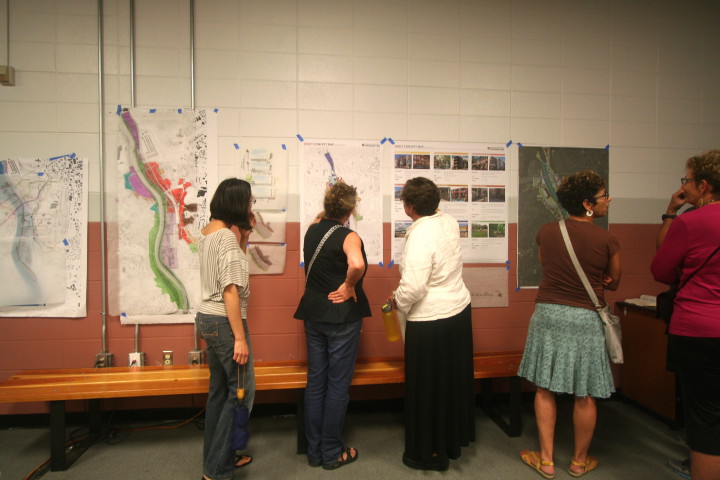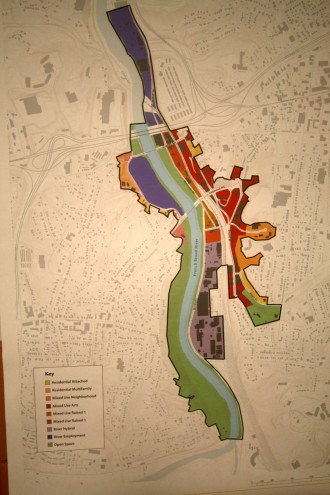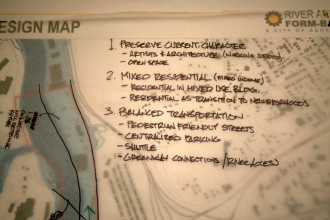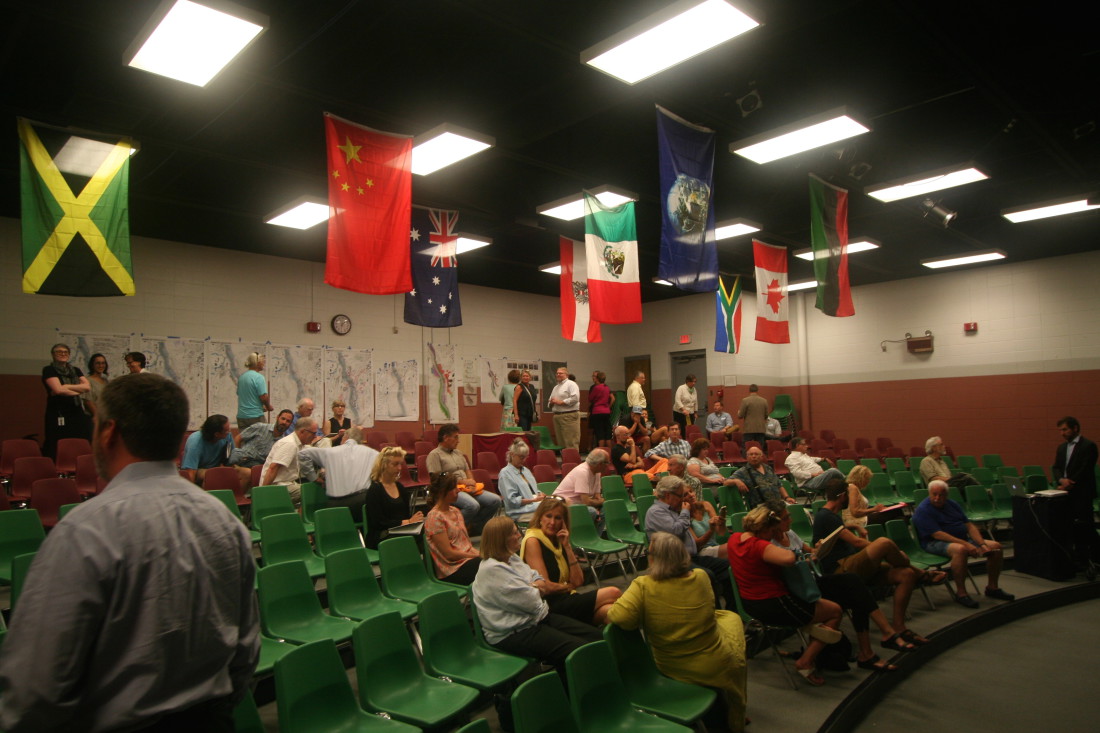Transportation concerns and maintaining a balance between the old and new were the highlights of the latest round of discussions on the River Arts District form-based coding project, with plenty of unanswered questions left on the table.
Along with flood mitigation and preserving greenspaces, those were the key issues identified by city consulting firms during a presentation Wednesday night recapping input from public meetings held over the last week and laying out a rough sketch for RAD’s future.
“We had moments where we wondered if we could ever get this done,” Vice Mayor Marc Hunt said. “The fact that so many of us are here tonight, and many have participated over the past four days to provide the first big input on the process, is incredibly encouraging.” While he acknowledged that there were still many questions around the future of the RAD, he noted that the completion of this portion of the project was an important “stopping point along the way for us to learn and get updated.”

Code Studio Principal Partner Lee Einsweiler explained some of the background motives for the coding process and reviewed the week’s activities. “There’s a lot of known issues in the area,” he noted, including “new development activity, the potential for displacing working artists, affordability issues related to flooding in the area and connectivity to the area from other parts of the city.”
Einsweiler added that the central question in all of this discussion is “whether we are harnessing that change to public ends or not. Are we getting what we want in this area?”
To address this question, Code Studio, Nelson-Nygaard Associates, Third Coast Design Studio, Noell Consulting Group and the city held a series of open houses, “lunch-and-learn” sessions and collaborative workshops over the course of the week, where citizens could ask questions, raise concerns, offer feedback and make suggestions on various aspects of the coding project. Einsweiler estimated that the number of people who attended this past week’s events eclipsed Code Studio’s 2012 meetings regarding the Haywood Road form-based coding project.
Along with subsequent meetings with City Council members and stakeholders, Code Studio and its team generated a series of maps and diagrams detailing the current state of the RAD, as well as several possible directions that future development could take within specific sectors of the study area. The firm also culled a list of common themes and concerns brought up by residents throughout the week, which Einsweiler said will become primary focuses as Code Studio drafts a final plan over the fall and winter.
Among these themes were connectivity, preserving the existing character of the RAD, parking options, supporting existing industry, developing community spaces and facilitating a 24-hour environment near the river, where “the sidewalks don’t roll up after six p.m.,” according to Einsweiler.

Nelson-Nygaard’s Joel Mann addressed the issue of connectivity between the RAD and surrounding parts of the city, identifying the current avenues of access and suggesting several possible methods for improving pedestrian and bicycle transportation through the surrounding area.
“Topography is a big issue,” he noted, adding that while many streets in and around the RAD run in close proximity to each other, rapid shifts in elevation make it difficult to feasibly connect these streets. To solve this issue, Mann suggested the use of pedestrian stairways leading from surrounding neighborhoods to the area, as well as improved pedestrian infrastructure along existing roadways.
The audience was also presented with several examples from other cities which had successfully integrated pedestrian structures into existing streetscapes. Mann highlighted Asheville’s Wall Street as “a national model for shared street design.”
In addition, Mann acknowledged the city for initiating the River Arts District Transportation Improvement Project, Livingston Complete Streets Project and efforts to improve Riverside Drive, saying that these current projects will “help facilitate traffic and movement” around the RAD.
Increased transportation options will become key, he added, as New Belgium ramps up their production in the coming year, generating a heavy increase in freight traffic. While form-based coding does not directly address traffic issues, Mann says it “can set up ways to guide people around” and “contributes to a complex, non-entangled system that works better as a whole and accommodates the different ways people will use it.”
Einsweiler then outlined the specific study areas within the RAD and discussed some of the tentative conclusions Code Studio had reached based on community input. “This is just one vision of what the future might bring,” he said, clarifying that nothing is written in stone as of yet. “We think the vision is grounded in reality, but it’s absolutely appropriate for the community to talk to us about specifics and see if we come to separate conclusion on sites.”
After a brief run-through of the various types of zoning included and the possible structures that would be allowed in each zone, Einsweiler dove into specific sections of the RAD, beginning with the “Northern Gateway,” which encompasses the area around the Smoky Park Supper Club, Zen Tubing and New Belgium. He said the brewery’s new tasting room, set to open in the spring of 2016, will largely determine the shape and focus of zoning in the northern sector. “If it’s on pace with projections, we’ll see 150 people an hour go in and out of tasting,” said Einsweiler, who added that “the issue will be watched carefully” by all involved in the form-based code project.
Another major concern to be taken into account is the position of the floodway along the northern corridor. “Most of the Northern Gateway sites there will have to be either elevated up on a pad site, like New Belgium, or elevated in other ways,” which could drive up construction and development costs.
For now, he advised that future zoning and development in the Northern Gateway should continue along the current “anything goes” path, while keeping an eye to what type of usage moves into the area in the coming years.
For the main section of the study area, referred to as the “Core,” Code Studio identified the character of existing buildings as “largely mix and match.” This area includes the majority of existing businesses and soon-to-come projects, including the RAD Lofts on Clingman Avenue, Wedge Brewing Company, White Duck Taco and a variety of other commercial and industrial businesses.

“Existing conditions vary,” Einsweiler said, noting that some of the western portions of the Core area lay within the 100-year flood zone. This section of the RAD is also where “you feel the industrial character the most,” he added, asserting that maintaining the character of the existing buildings was a primary concern to residents and city planners alike.
To address this concern, Code Studio suggests using the steep topography to effectively camouflage new, larger buildings from the street level. “we could constrain [development] to two stories at the street,” Einsweiler said, while “generat[ing] as much as six stories” on the downslope side of a steeply graded property, similar to the construction of the Hatchery Studios building on Robert’s Street.
“It’s a way to bring a fair amount of increased activity to the area without threatening the current fabric,” he added.
Meanwhile, uncertainty still exists regarding future plans for the “Southern Gateway” area, which includes the parcels in the vicinity of Mountain Energy and Riverview Station. Einsweiler highlighted the need to connect Riverview with the northern portions of the RAD, suggesting that pedestrian bridges over the existing rail lines are a possibility. However, he noted that no discussions have yet taken place with Norfolk Southern, who owns the railway.
Other questions for the area include how to best utilize the properties, which the Code Studio team and project consultants identified as “the largest available space in the city right now.” While ideas of encouraging industrial redevelopment or adding residential properties to the area have been floated, Einsweiler noted that substantial concerns regarding flood mitigation and garnering the best possible value for the land present challenges to city planners and zoning officials.
For now, Code Studio is suggesting a “hybrid industrial parcel” closer to the river, with mixed-use properties extending back toward Ralph Street in the southern sector. However, Einsweiler and his team encouraged community feedback on this site as the project moves forward, saying that “we’re all going to have to keep our thinking caps on about how to keep this thriving and alive and connected to the rest of the River District.”
In addition to the discussion of proper zoning for commercial, residential and industrial use throughout the RAD, Code Studio envisions separate zoning for parks and greenways throughout the District, something that Einsweiler says hasn’t been done by the city in the past.
“We’d love it if the zoning map has a bunch of green sticking out where all the public investment has gotten us parks,” he said, suggesting that a parks district could “allow for [recreational] uses but constrain other involvement.”
Code Studio’s presentation finished with a reminder that the public comment period is still open online for the next 60 days through Code Studio’s official project webpage and Facebook page. An exit survey was also passed out to attendees, soliciting feedback on the charette process.

One attendee and local resident Xpress spoke with said that he felt “it was a good meeting,” but acknowledged that there are “still a lot of things to work out. We’ll see where it goes from here.” Others in attendance were less impressed, with some questioning the uncertainty still surrounding specific details of the coding plans.
From here, Code Studio will review the information gathered during the past week and post a report online at the project website. The firm will then spend the fall and winter drafting a final code report, which will be formally presented to the Planning and Zoning Commission and City Council in the Spring of 2016.
For more information on the form-based code, Code Studio’s drafts and preliminary sketches, or to submit a comment or question, visit code-studio.com/rad/ or the official Facebook page at facebook.com/radformbasedcode. For updates on the river Arts District form-based coding project, visit the city of Asheville’s blog at coablog.ashevillenc.gov.




Before you comment
The comments section is here to provide a platform for civil dialogue on the issues we face together as a local community. Xpress is committed to offering this platform for all voices, but when the tone of the discussion gets nasty or strays off topic, we believe many people choose not to participate. Xpress editors are determined to moderate comments to ensure a constructive interchange is maintained. All comments judged not to be in keeping with the spirit of civil discourse will be removed and repeat violators will be banned. See here for our terms of service. Thank you for being part of this effort to promote respectful discussion.